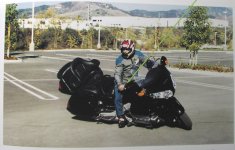Burning1
I'm scareoused!
The simple fact is that if you have enough grip to wind on the gas harder, you could have been cornering faster and you're not at the limit of grip.
Absolutely true. The bike would benefit from raising the rear end up and installing rear-sets. Despite the fact that I have photos of my elbow a few inches from the ground. The bike really is limited by cornering clearance, rather than traction.
Last edited:






 .
. 